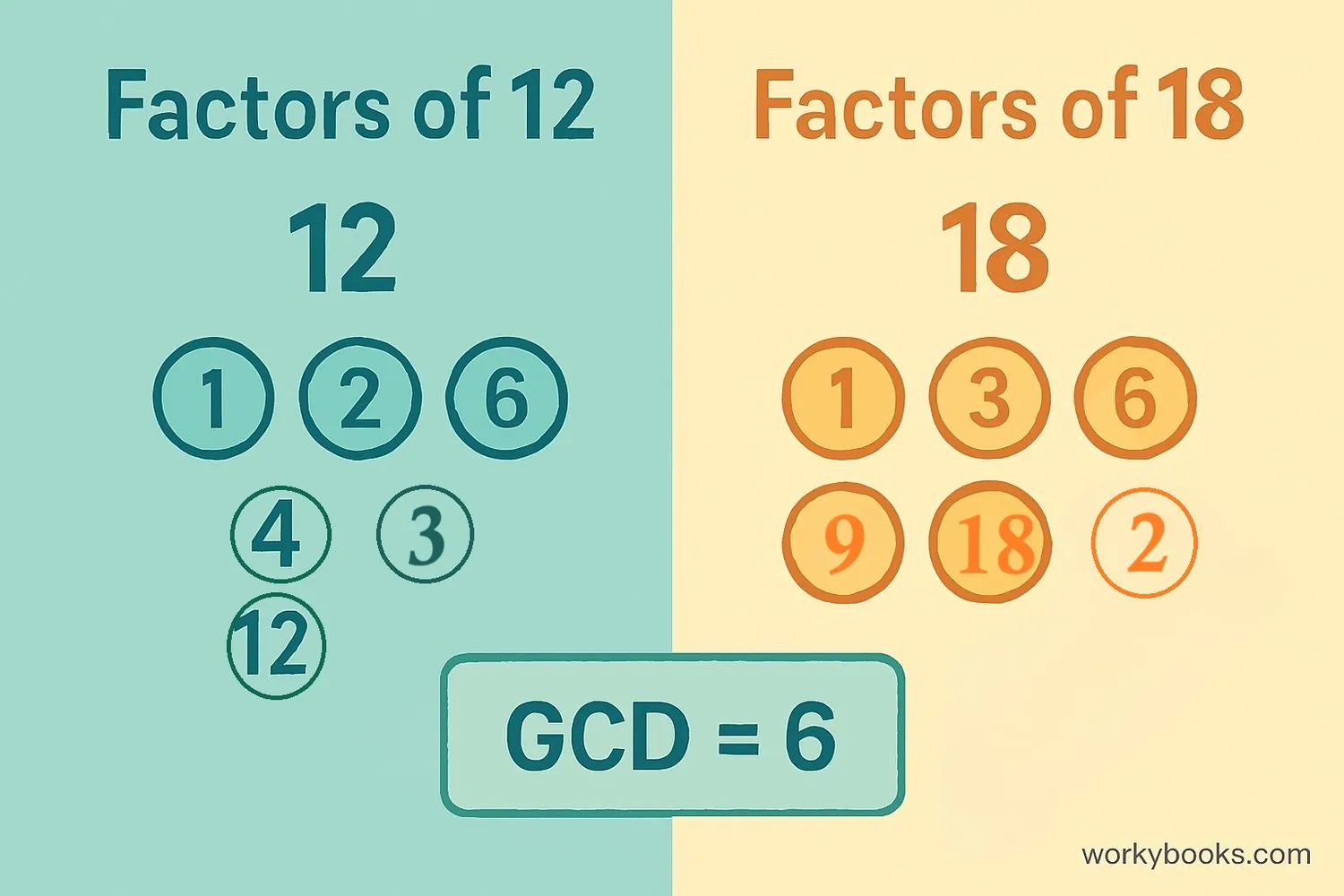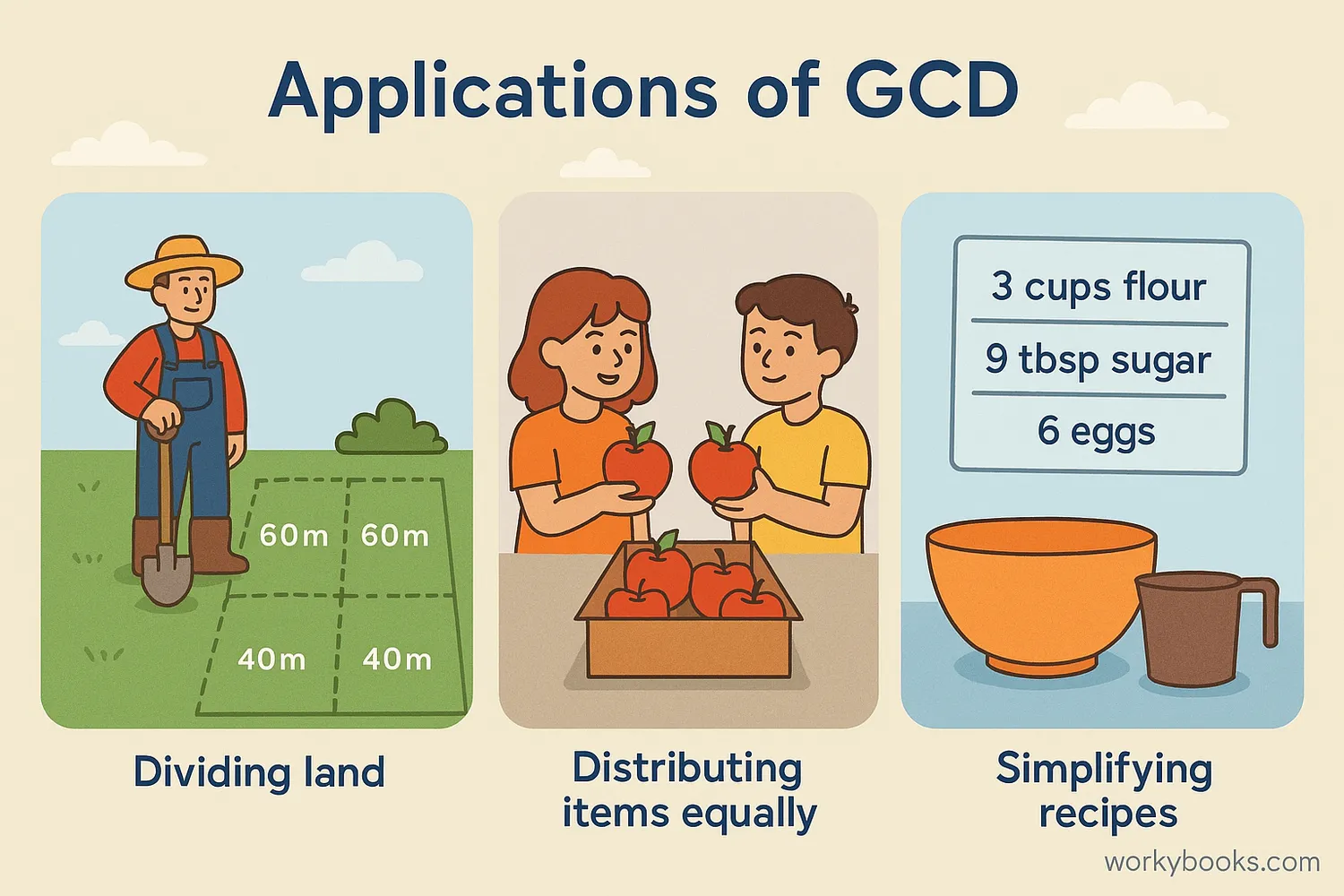Greatest Common Divisor (GCD) - Definition, Examples, Quiz, FAQ, Trivia
Learn to find the largest number that divides two or more numbers with easy explanations and practice activities
What is Greatest Common Divisor?

The Greatest Common Divisor (GCD), also known as the Greatest Common Factor (GCF), is the largest number that divides two or more numbers without leaving a remainder.
Think of it like finding the biggest number that can evenly divide into all the numbers you're working with. For example, the GCD of 12 and 18 is 6 because 6 is the largest number that divides both 12 and 18.
GCD is useful in many real-life situations like simplifying fractions, dividing things into equal groups, and solving problems in mathematics.
Key Concept
The GCD is the largest number that is a factor of two or more numbers. For example, GCD of 8 and 12 is 4.
How to Find the Greatest Common Divisor
There are several methods to find the GCD of two or more numbers. The two most common methods are:
1. Listing Factors Method: List all factors of each number and find the largest common factor.
2. Prime Factorization Method: Find the prime factors of each number and multiply the common prime factors.
3. Euclidean Algorithm: A more efficient method for larger numbers that uses repeated division.
Let's look at each method in detail.
Remember
The GCD of any two numbers is always at least 1, since 1 divides every number.
Methods to Find GCD
1. Listing Factors Method
1 List all factors of each number
For example, to find GCD of 24 and 36:
Factors of 24: 1, 2, 3, 4, 6, 8, 12, 24
Factors of 36: 1, 2, 3, 4, 6, 9, 12, 18, 36
2 Identify common factors
Common factors: 1, 2, 3, 4, 6, 12
3 Select the greatest common factor
The greatest common factor is 12, so GCD(24, 36) = 12
2. Prime Factorization Method
1 Find prime factors of each number
For example, to find GCD of 24 and 36:
24 = 2 × 2 × 2 × 3
36 = 2 × 2 × 3 × 3
2 Identify common prime factors
Common prime factors: 2, 2, 3
3 Multiply the common prime factors
2 × 2 × 3 = 12, so GCD(24, 36) = 12
3. Euclidean Algorithm
1 Divide the larger number by the smaller number
For example, to find GCD of 48 and 18:
48 ÷ 18 = 2 with remainder 12
2 Replace the larger number with the smaller number, and the smaller number with the remainder
Now find GCD of 18 and 12
3 Repeat until the remainder is 0
18 ÷ 12 = 1 with remainder 6
12 ÷ 6 = 2 with remainder 0
When remainder is 0, the divisor (6) is the GCD
Method Tip
Use the listing factors method for smaller numbers and the Euclidean algorithm for larger numbers.
Real-World Examples

Let's practice finding GCD with some real-world examples:
Example 1: Sarah has 12 apples and 18 oranges. She wants to make identical fruit baskets with the same combination of apples and oranges in each basket. What is the greatest number of baskets she can make?
Solution: Find GCD of 12 and 18.
Factors of 12: 1, 2, 3, 4, 6, 12
Factors of 18: 1, 2, 3, 6, 9, 18
GCD = 6. She can make 6 baskets.
Example 2: A rectangular room is 24 feet by 30 feet. What is the largest size of square tiles that can evenly cover the floor?
Solution: Find GCD of 24 and 30.
Using Euclidean algorithm:
30 ÷ 24 = 1 with remainder 6
24 ÷ 6 = 4 with remainder 0
GCD = 6. The largest square tiles are 6ft × 6ft.
Example 3: Simplify the fraction 16/24 using GCD.
Solution: Find GCD of 16 and 24.
Factors of 16: 1, 2, 4, 8, 16
Factors of 24: 1, 2, 3, 4, 6, 8, 12, 24
GCD = 8. Divide numerator and denominator by 8: 16÷8/24÷8 = 2/3
Practice finding GCD in your daily life - when sharing food, dividing groups, or working with fractions!
Application Tip
GCD is especially useful when you need to divide things into the largest possible equal groups without leftovers.
GCD Practice Quiz
Test your understanding with this 5-question quiz. Choose the correct answer for each question.
Frequently Asked Questions
Here are answers to common questions about Greatest Common Divisor:
Math Trivia
Discover interesting facts about numbers and the Greatest Common Divisor:
Ancient Algorithm
The Euclidean algorithm for finding GCD is over 2,300 years old, making it one of the oldest algorithms still in use today. It was described by Euclid in his famous work "Elements".
GCD of Prime Numbers
The GCD of any two distinct prime numbers is always 1. This is because prime numbers have no factors other than 1 and themselves, so they can't share any common factors other than 1.
Music and GCD
GCD is used in music theory to determine the rhythm and timing of musical notes. It helps find the fundamental beat when different note durations are played together.
Large Number GCD
Computers use the Euclidean algorithm to find GCD of very large numbers efficiently, which is important for cryptography and internet security applications.





